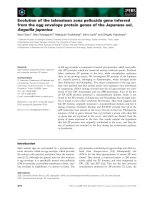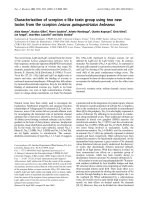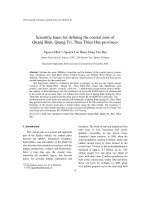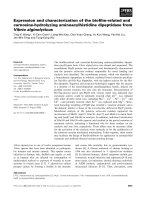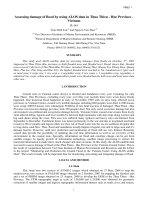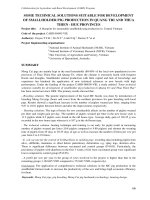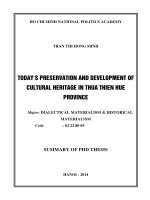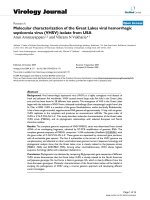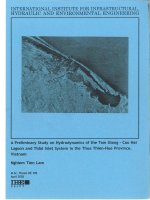Characterization of giant mottled eel (anguilla marmorata) gastrointestinal tract that origin from thua thien hue, vietnam
Bạn đang xem bản rút gọn của tài liệu. Xem và tải ngay bản đầy đủ của tài liệu tại đây (412.04 KB, 6 trang )
/>
Research Article
Characterization of giant mottled eel (Anguilla marmorata)
gastrointestinal tract that origin from Thua Thien Hue, Vietnam.
Kieu Thi Huyen1, Nguyen Quang Linh2*
Faculty of Fisheries, University of Agriculture and Forestry, Hue University, Thua Thien Hue, Hue City 530000, Vietnam
Department of Nutritional Diseases and Systems for Livestock and Aquaculture, Institute of Biotechnology, Hue
University, Thua Thien Hue, Hue City 530000, Vietnam
1
2
Abstract
This study investigated the dietary component and morphology of the digestive tract of Anguilla
marmorata during its yellow stages (non-migrants). A total of 127 samples, ranging in total length
from 17-108 cm and weight from 10-3200 g were collected from Thua Thien Hue, Vietnam.
The structure of the gastrointestinal tract indicated that Anguilla marmorata has the typical
characters of carnivorous fish such as a wide mouth, small teeth in bands; free tongue; short
esophagus, stomach, and intestines made up of folds. The mouth size of Anguilla marmorata
ranged from 1.81-6.6 cm and it increased with the body weight of fish. Anguilla marmorata is
an animal-eating species with an RLG (relative length of the gut) ranging from 0.34 to 0.41
(RLG <1). Crustacea is the preferred food of eels with the highest proportion of the number,
weight, and frequency of crustaceans in the gastrointestinal tract with 65%, 64%, and 80%,
respectively. Crustacea was also the most important food of Anguilla marmorata in the wild
with the index of relative importance (IRI%)=79%. Correlation equation between length (L=17108 cm) and weight (W=10-3200 g) of Anguilla marmorata is L=9.948W0.0622 with correlation
coefficient R2=0.93. Our report provides new dietary information about A. marmorata that is
useful in nutrition planning and aquaculture potential.
Keywords: Teeth, Mouth size, Intestine, IRI%, Carnivorous fish.
Accepted on October 23, 2019
Introduction
There are 16 species and 3 subspecies of freshwater eels in
the world [1,2]. Anguilla marmorata has a wide distribution
throughout most of the tropical and subtropical western-central
Pacific and Indian Oceans and associated freshwater systems.
This species is a highly prized as commercial food fish. Once
the fish has achieved yellow and silver life stages, the species
could succumb to overfishing. Additional fishing pressure of
A. marmorata could origin from seed-stock for farming [3].
The yellow eel growth stage may be as short as two to three
years in warm productive habitats, but about six to 20 years or
more in more northerly latitudes, e.g. in the Pearl River, China
[4]. Female eels that have reached the age of sexual maturity
will swim downstream in large groups to lower stream areas
or to the river mouth to meet up with the male eels and then
they will travel all the way to deep ocean sea areas for mating
and spawning [5]. A. marmorata has been found in the deep
sea areas south of the Philippines, eastern Indonesia, and Papua
New Guinea. After spawning, the adults die, and the eggs then
drift along to the ocean. The young hatch as a white, weakly
shaped eel with the appearance a leaf. When they arrive at the
coast they transform into an infant eel with a, short round body.
This stage of development is sometimes called the eagle stage.
Following further development they move into streams to live
in fresh water [6].
4
The nutritional habits of eel will be change by living
conditions and migration patterns in their life cycle. The feeding
ecology of eel is not similar in different species. The feeding
ecology of some tropical species of eel still remains almost
completely unknown while temperate species have been best
described. The four most well-investigated eel species are
Anguilla anguilla, Anguilla rostrata, Anguilla dieffenbachii,
and Anguilla australis and of these, A. anguilla is the only best
described species [7]. Since the 1930s, the commercial and
cultural aspects have without a doubt been the most important
drivers of interest in attaining knowledge on the feeding ecology
of the different life-stages of freshwater eels [8,9]. Nevertheless,
the current knowledge-base largely relates to the yellow eel
stage of Anguilla eels and the feeding ecology of the larval stage
(leptocephali) is still poorly understood [10,11]. The severe
decline in freshwater eel populations over the last 30 years or
more [12,13] provided an additional important driver for need
to establish knowledge on their feeding ecology. Resh et al.
[14] investigated the diet of A. marmorata and A. obscura in
Rivers in the tidal zone in Moorea Island, French Polynesia. The
low number of individuals studied does not allow for any firm
conclusions to be drawn on their diet [14]. A study of Butler and
Marshall [15] demonstrated that A. labiata in the upper Kairezi
River, Zimbabwe predominantly fed on freshwater crustaceans
[15].
J Fish Res 2019 Volume 3 Issue 2
Citation: Huyen KT, Linh NQ. Characterization of giant mottled eel (Anguilla marmorata) gastrointestinal tract that origin from Thua Thien Hue,
Vietnam.. J Fish Res. 2019;3(2):4-9.
In Vietnam, studies indicate that there are four species of eel
in the Anguilla group. A. marmorata, A. japonica, A. bicolor
pacifica, A. bornesensis [16]. According to Phu [17], many
species of eel are widely distributed and have economic value
to fisher man particularly in the provinces from Quang Tri to
Khanh Hoa [17]. In Thua Thien Hue, A. marmorata is one of two
Anguilla species identified by [18,19] base on morphological
characteristics analyzed. Anguilla marmorata is also widely
distributed, exploited and cultivated with high economic value.
However, the understanding of the nutritional characteristics
of Anguilla marmorata have not been conducted in Vietnam.
Here we report new information on the natural diet of Anguilla
marmorata at the yellow stage to clarify the nutritional and
growth characteristics of the eel in the wild. Our report provides
new dietary information about A. marmorata that is useful in
nutrition planning and aquaculture. The results of these studies
will provide the basis for the development of more efficient
reproduction, nursing, and aquaculture processes.
Material and Methods
There were 127 marbled eels (Anguilla marmorata)
collected from the study areas in Thua Thien Hue (Table 1) with
sizes from (total length range) and having weights ranging 10
g to 3200 g (Table 2) when the eels were gathered in July and
August 2018.
After collection, the specimens were stored in cold
water (15oC) before incubation at -30oC to prevent the food
contents of the digestive tract from being decomposed. The
anatomy of the eel’s digestive system such as the mouth, teeth,
esophagus, stomach, intestines, were observed and described
basic characteristics and images of them. The natural diet
was determined by the morphological characteristics and
composition of foods in the gastrointestinal tract. The samples
were divided into 4 groups to characterize their diets (Table 2).
The ratio of gut length and standard length was calculated
according to the formula of Al-Hussainy: RLG=Li / L. The
size of eel mouth were measured and calculated according to
the formula proposed by Shirota: MH=AB * √2 with AB is the
upper jaw length (mm), MH is the mouth size when opening 900
(mm) [20].
Table 1. The number of samples collected.
No.
Number of samples
Ratio %
1
Locations
Thao Long Dam
26
20
2
Truoi Dam
18
14
3
Cua Lac Dam
15
12
4
Nam Dong district
16
13
5
PhongDien district
28
22
6
PhuLoc district
Total
24
19
127
100
Table 2. Distribution of samples by weight.
Group
Weight (g)
Number of samples
1
10-100
32
2
101 – 500
35
3
501 – 1000
30
4
1001 – 3200
30
J Fish Res 2019 Volume 3 Issue 2
The food contents of the fish intestinanal tract was observed
using a magnifying glass or microscope. The feed ingredients
were classified into 4 groups: fish, crustaceans, mollusca, and
others (organic sludge and unidentified) based on methods inthe
published literature [16].
In order to determine the role of foods by different size
groups, we used some approaches such as the numerical and
weight methods described by Biswas [21], combined with
frequency appearing method as described by Hynes [22]. At the
same time, the index of relative importance (IRI%) was also
used. The IRI% provides the correlation coefficient percentage
of a food group with the total correlation coefficient calculated
by the following formula [23]:
IRI i % =
IRI i
×100
n
∑ IRI
i =1
i
The IRI is the relative index of each feed group for the study
population and the index was calculated by the formula: IRI =
(N%+W%) x O%. In which, N% is the percentage by number of
each food group within the digestive tract, W% is the percentage
by weight of each food group in the digestive tract and O% is
the appearing frequency of each food in intestine.
In addition, the correlation between length and weight was
calculated by the formula of Beverton - Holt: W=a . With, “W”
is total body weight of eel (g), “L” is total body length of eel (cm),
“a” is the initial growth constant, “b” is the growth factor [24].
All data in this study was collected, analyzed and evaluated
by Microsoft Excel 2016 software.
Results and Discussion
Morphological characteristics of the Anguilla marmorata
digestive system
Morphology of the mouth and teeth: The eel's mouth is
long and pointed, thick lips, a long mouth incision. The lower
jaw has a larger size than the upper jaw. The free tongue does
not stick to the bottom of the mouth with an oval shape (Figure
1). The composition of the teeth is one of the indicators showing
the eating habits of fish. Eel teeth are pointed, shaped like dog
teeth, placed on the jaw and the main oral cavity forming strips.
Upper maxillary teeth are arranged like arrows while lower jaw
include two rows of pointed teeth with spaces larger than the
upper maxillary (Figure 2).
Characteristics of the digestive organs: The esophagus
is a continuous section of the mouth cavity. The junction of
the esophagus and stomach is usually unclear. The esophagus
moves food down to the stomach. The esophagus of most fish is
short. Different fish species have varyingdegrees of esophagus
elasticity [24]. The eel's esophagus is tubular, short, thickwalled, the inside with many folds and good elasticity.
The liver is the largest digestive gland of fish. The important
task of the liver is secretion of blue-green bile into the
gallbladder and the small intestine through the bile duct, while
the liver is also a detoxification organ of fish. The liver of eel is
large, dark brown to light reddish brown, located at the top of
the internal cavity. The gall bladder is separated from the liver,
5
Huyen/Linh
Figure 1. Morphology of mouth and tongue. (A - Vertical form; B - Horizontal shape)
Figure 2.Morphology of teeth. (A - Upper jaw; B- Lower jaw)
located below the liver and covered by esophagus and stomach.
The gall bladder is large, oval in shape, dark brown in color
contains yellow-green bile. The gall bladder is connected with
the stomach by a duct from the liver and a tube down to the front
of the intestine (Figure 3).
The stomach is located next to the esophagus. The task of
the stomach is to contain food and digestive enzymes involved
in the digestive process of food. The stomach usually has a
relationship with food and size of prey. Large stomach fishes
are capable of eating large prey species and vice versa [25]. The
stomach of the eel has a large bag shape with a thick wall, and
the inside has many folds to create high elasticity that allows the
stomach to accept large food items as contents. The intestine is
the end piece of the digestive tract that terminates with the anus.
The task of the intestine is food fermentation and digestion
using enzymes from digestive glands. Digested food is then
absorbed as nutrients into the bloodstream. The eel's intestine is
tubular, folded and relatively short. The intestinal wall is thick
with many folds on the inside (Figure 3).
The mouth reaches to under the rear edge of the eyes with
a projecting lower jaw and a visible patch that conspicuously
narrows in its middle on the roof of the mouth. Other
characteristics include thick lips and minute teeth in bands
separated by a toothless groove on the upper jaw separating
the inner and outer teeth [26]. Loan Nguyen Bach, described
it as a large-sized fish with large sharp doglike teeth [27,28].
According to Yen MD, et al. [29], animal-eating species often
have a large mouth size, pointed teeth in two jaws, ploughshare,
and palatine. They have a short intestine and stomach separated
from intestinal bundles. There for, the structural characteristics
of A. marmorata’s digestive system have been described as
consistent with a carnivorous species.
Change of mouth size and the ratio of intestinal length and
body length
Changes of mouth size of Anguilla marmorata: The fish's
6
Figure 3. Morphylogy of the digestive organ.
mouth size influences its feeding habit where prey-to-mouth size
of 45 % is maximum entry limit [20,30]. For eels, fish mouth
size increases with the development of the fish. Fish weighing
from 10 to 100 g have mouth size is 1.81 cm corresponding to
the body length of 28.18 cm. The mouth size of eel increased
significantly when its weight reaches between 101-500 g. For
instance, an eel measuring 45.63 cm has mouth size of 3.21 cm.
The eel with body weight from 501 to 1000 g has mouth size
was 4.53 cm. When reaching the weight of 1001-3200 g, the
mouth size of the eel was 6.6 cm with an average body length
of 96 cm (Table 3).
The ratio of intestine length and total length (RLG): The
results in Table 4 show that the value of RLG index of Anguilla
marmorata with weights ranging from 10 to 3200 g ranges from
J Fish Res 2019 Volume 3 Issue 2
Citation: Huyen KT, Linh NQ. Characterization of giant mottled eel (Anguilla marmorata) gastrointestinal tract that origin from Thua Thien Hue,
Vietnam.. J Fish Res. 2019;3(2):4-9.
that the number of crustaceans (shrimps, crabs) in the eel’s
gastrointestinal tract accounts for the highest proportion of all
food groups (65%), which tends to increase with the development
of fish from 53% to 75%. Fish is the second largest component
that accounts for 21% of the digestive tract content of eels and
fish prey decrease over the developmental stages (down from
29% to 15%). The same trend was observed with the mollusca
group with a gradual decrease of 12% to 5%. Other components
show very low amounts containing only 5%.
Table 3. The mouth size of eel by size groups.
Group
Length (cm)
Upper jaw length (cm)
Mouth size (cm)
1
28.18 ± 6.137
1.28 ± 0.318
1.81 ± 0.449
2
45.63 ± 6.431
2.27 ± 0.399
3.21 ± 0.564
3
60.75± 0.829
3.20 ± 0.122
4.53 ± 0.173
4
96.00 ± 16.971
4.67 ± 0.544
6.60 ± 0.769
Table 4. RLG value of eel.
Group
Total length
Intestinal length
RLG
1
28.18 ± 6.137
9.54 ± 2.126
0.34 ± 0.041
2
45.63 ± 6.431
16.99 ± 3.831
0.37 ± 0.059
3
60.75± 0.829
23.88 ± 5.572
0.39 ± 0.095
4
96.00 ± 16.971
39.50 ± 7.778
0.41 ± 0.073
At the same time, the results of a survey on the weight of
the feeding groups in the eel's gastrointestinal tract showed that
crustaceans were the largest weight, accounting for from 59%
to 75% of total diets (average of 64%). Fish prey accounted
for an average of 29% of total weight feed (from 17% to
33%). Molluscas and others occupy only small amounts in
the gastrointestinal tract of eels with 5% and 2%, respectively
(Table 5).
0.34 to 0.41 (RLG<1) and increases by body weight. The lowest
value of RLG is 0.34 that belong to the size group of 100 to 250
g. The RLG value of 2 groups: 251-500 g and 501-1000 g are
0.37 and 0.39 respectively. The RLG value of the >1000 g group
is the highest at 0.41.
In addition, the values in Table 5 also show that the
frequency of crustaceans is the highest in the eel's natural diet
with an average of 80% for all of the group size. In each group,
the frequency of crustaceans was also higher than that of other
foods, especially in the group of 101-500 g, where the frequency
of crustaceans was up to 93%. Fish is the second most frequently
occurring food in the gastrointestinal tract with a mean value
of 49% in all groups. Molluscas has an average occurrence
frequency of 24% and tends to decrease with the development
of eels. Other types of food such as soil, roots, garbage, cannot
be digested and remain intact in the intestinal tract; this group
only appears about 12%. This is not the food that fish prefer, and
it is only eaten at random during the ingestion of other foods.
According to Biswas, individuals in the same species differ
in the RLG index depending on the stage of development of
the fish [21]. According to Smith, the gut length depends on
the age and nature of the food they consume, the length of the
bowel increases with the increase in the proportion of plant
foods in the fish diet. Girgis (linked by Liem PT and Dinh TD)
also argues that the RLG value is low at the juvenile stage and
high at the adult stage [24]. During growth, the digestive tract
of the fish will increase in length and increase the folds to digest
and absorb nutrients, which leads to increased RLG values [28].
In addition, animal-eating fish (carnivorous) usually have the
value of RLG is ≤ 1, omnivorous fish have the value of RLG
from 1 to 3 and that for plant-eating fish (herbivorous) is > 3
[31], indicating that Anguilla marmorata is a carnivorous fish.
The role of foods in the eel’s gastrointestinal tract: The
data from Table 6 shows that the value of IRI% for crustacea is
highest in the digestive tract of eel with an average of 79% in all
size groups. This value tends to increase with the development
of fish. Fish are the second most important food in the gut of
the eel with a mean IRI% of 18%. Mollusca have a much lower
value than crustaceans and fish, while IRI% is only 2%. The
The composition and role of natural foods in gastrointestinal
tract of Anguilla marmorata
The composition of natural foods in the eel’s
gastrointestinal tract: The figures from Table 5 indicated
Table 5. The composition of food in the gastrointestinal tract of eel (%).
Species of foods
Group
Crustacea
1
Fish
Mollusca
Others
Nf
Wf
Ff
Nf
Wf
Ff
Nf
Wf
Ff
Nf
Wf
Ff
53
59
71
29
28
57
12
6
29
6
6
14
2
65
61
93
20
32
47
11
5
27
4
2
13
3
67
75
88
21
17
63
6
5
25
6
4
13
4
75
61
64
15
33
36
5
4
18
5
2
9
Average
65
64
80
21
29
49
9
5
24
5
2
12
Note: Nf: The amount of the number of foods in the gastrointestinal tract; Wf: The amount of the weight of foods in the gastrointestinal tract; Ff:
the frequency of food in the digestive tract.
Table 6. Correlation index (IRI%) of foods in the gastrointestinal tract.
Group
Species of food
Crustacea
Fish
Mollusca
Others
1
67
27
4
1
2
80
17
3
0
3
82
16
2
1
4
81
16
2
1
Average
79
18
2
1
J Fish Res 2019 Volume 3 Issue 2
7
Huyen/Linh
Correlation equations between length (L=17-108 cm) and
weight (W=10-3200 g) from 127 individuals in this study of
Anguilla marmorata were L=9.948W0.0622 with correlation
coefficient R2=0.9083 indicating a strong correlation between
length and weight. The growth rate of the length tends to
decrease with the increase in body weight.
Acknowledgement
This study was financially supported by PhD scholarship
2018 of Southeast Asian Regional Center for Graduate Study
and Research in Agriculture (SEARCA) College, Los Baños,
Laguna 4031, Philippines and Hue University (No. DHH201902-113), 03 Le Loi, Vinh Ninh, Hue city, Thua Thien Hue,
Vietnam.
Figure 4. The correlation between length and weight.
role of other foods is negligible (1%). There is no significant
difference in the role of foods in the gastrointestinal tract of
each size group. Thus, crustacean food is the most important
item in the gastrointestinal tract of Anguilla marmorata.
Correlation between body length and weight
Growth is the process of increasing body size and weight;
this process is characteristic of individual fish species and is
expressed by the length and weight correlation of fish [31].
The correlation between total length and body weight of eel is
shown in Figure 4.
The correlation equation between length (L=17-108 cm)
and weight (W=10-3200 g) of 127 individuals of Anguilla
marmorata was L = 9.948W0.0622 with a correlation coefficient
R2=0,93. A value of R2=0.9083 was obtained in the range of 10
to 3200 g indicating a strong correlation between length and
weight of Anguilla marmorata. A correlation coefficient R2>0.9
is very high [32]. A. marmorata grow rapidly in terms of body
length during development until their body mass reaches 2000
g, the length growth tends to slow down. In addition, during the
evolution of the eel from 7-3200 g, fish became less rotund as
length increases (b<3).
Conclusion
Morphological characteristics of the gastrointestinal tract show
that Anguilla marmorata is a carnivorous fish. They have a long
and pointed mouth, the sharp of teeth look like a dog arranged on
two jaws and the main oral bones and free tongue. The eel has a
large mouth size, varying by body weight. The larger the fish, the
larger the size of the mouth. The size of the mouth of eel ranged
from 1.81 to 6.6 cm in the mass range of 10-3200 g.
The stomach and intestines of Anguilla marmorata are
short, with many folds having great elasticity. The RLG value
of Anguilla marmorata fluctuates between 0.34 and 0.41 and
less than 1, which is characteristic for fish-eating species.
The eel's natural feed ingredients include crustaceans, fish,
mollusks, and other species. Crustaceans are the most abundant
species in the gastrointestinal tract, with 68% of the number,
64% of weight, 80% of frequency and 79% for IGI% index.
8
References
1. Ege V. A revision of the genus Anguilla shaw, a systematic,
phylogenetic and geographical study. Dana Rep. 1939;16:1256.
2. Watanabe S, Aoyama J, Tsukamoto K. A new species of
freshwater eel Anguilla luzonensis (Teleostei: Anguillidae)
from Luzon island of the Philippines. Fish Sci. 2009;75:387-92.
3. Jacoby D, Gollock M. Anguilla marmorata. The IUCN red
list of threatened species. 2014.
4. Williamson GR, Boëtius J. The eels Anguilla Marmorata
and A. Japonica in the Pearl river, China, and Hong Kong.
Asian Fisheries Science. 1994;6:129-138.
5. McCosker JE, Bustamante RH, Wellington GM. The
freshwater eel, Anguilla marmorata, discovered at
Galapagos. Noticias de Galapagos. 2003;62:2-6.
6. Rainboth WJ. Fishes of the cambodian mekong. FAO
Species identification field guide for fishery purposes. FAO.
Rome. 1996.
7. Takaomi Arai. Biology and ecology of Anguillid eels. Taylor
& Francis Group. CRC Press. 2016.
8. Godfrey H. Feeding of eels in four new Brunswick salmon
streams. Progress Reports for the Atlantic Stations.
Biological Station St. Andrews. Ottawa. 1957.
9. Tesch FW. The Eel. 3rd Edn. Blackwell Science Ltd. Oxford.
United Kingdom. 2003.
10. Terahara TS, Chow HK, Lee SH, et al. Efficiency of peptide
nucleic acid-directed PCR clamping and its application
in the investigation of natural diets of the Japanese eel
Leptocephali. PlosONE. 2011;6:e25715.
11. Miller MJ, Chikaraishi Y, Ogawa NO, et al. A low trophic
position of japanese eel larvae indicates feeding on marine
snow. Biol Lett. 2013;9(1):20120826.
12. Moriarty C, Dekker W. Management of the European eel—
enhancement of the European eel fishery and conservation
of the species. Irish Fisheries Bulletin. Dublin. 1997;15.
13. Dekker W. What caused the decline of the Lake IJsselmeer
Eel stock after 1960. ICES J Mar Sci. 2004;61:394-404.
J Fish Res 2019 Volume 3 Issue 2
Citation: Huyen KT, Linh NQ. Characterization of giant mottled eel (Anguilla marmorata) gastrointestinal tract that origin from Thua Thien Hue,
Vietnam.. J Fish Res. 2019;3(2):4-9.
14. Resh VH, Moser M, Poole M. Feeding habits of some
freshwater fishes in streams of Moorea, French Polynesia.
Annls Limnol. 1999;35(3):205-10.
23. Enric Cortes. A critical review of methods of studying fish
feeding based on analysis of stomach contents: application to
elasmobranch fishes. Can J Fish Aqua Sci. 1996;54:726-738.
15. Butler JRA, Marshall BE. Resource use within the crabeating guild of the upper Kairezi River. Zimbabwe. J Trop
Ecol. 1996;12:475-90.
24. Liem PT, Dinh TD. Fish biology research methods. Chapter 4:
Fish nutrition research methods. Can Tho University. 2004.
16. Yen MD, Duc NH. Freshwater fish families in northern
provinces of Vietnam. Science and Technology Publishing
House. Hanoi. 1987.
17. Phu VV. Species composition of the fish and biological
characteristics of 10 economic fish species in Thua Thien
Hue Lagoon. National University. Hanoi. 1995.
18. Phu VV. Species composition of the fish in Thua Thien Hue
Lagoon. Journal of Biology. 1997;19(2):14-22.
19. Phu VV, Thuan ND. Fish composition of O Lau River, Thua
Thien Hue Province. Journal of Research and Development.
2009;55:61-71.
20. Shirota A. Studies on the mouth size of fish larvae. Nippon
Suisan Gakkaishi. 1970;36:353-68.
21. Biswas SP. Manual of method in fish biology. South Asian
Publishers Pvt. Ltd. New Delhi. India. 1993.
22. Hynes HB. The food of freshwater sticklebacks
(Gasterosterus aculeatus and Pygosteus pungitius), with
a review of the methods used in studies of the food of the
fishes. J Anim Ecol. 1950;19:36-58.
25. Smith DG. Anguillidae. Freshwater eels. FAO species
identification guide for fishery purposes. The living marine
resources of the western central pacific. FAO. Rome.
1999;3:1630-6.
26. Jacoby D, Gollock M. Anguilla marmorata. The IUCN red
list of threatened species. 2014.
27. Loan NB. Classification and biological characteristics of
freshwater fish species in the lower Mekong river, Vietnam.
Cantho University. 1998.
28. Loan NB. Curriculum I. Can Tho University. 2004.
29. McCosker, Yen MD. Aquaculture. Publisher of University
and Secondary School. 1979;390p.
30. Cunha I, Planas M. Optimal prey size for early turbot larvae
(Scophthalmus Maximus) base on mouth and ingested prey
size. Aquaculture. 1999;175:103-110.
31. Nikolsky GV. Ecology of fishes. Academic Press. London.
1963;352.
32. Giap, Dang V. Analysis of scientific data by MS-Excel. The
Education Publishing House. 2007.
*Correspondence to:
Nguyen Quang Linh
Institute of Biotechnology
Hue University
Thua Thien Hue,
Hue City 530000,
Vietnam
E-mail:
J Fish Res 2019 Volume 3 Issue 2
9
